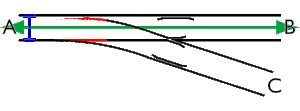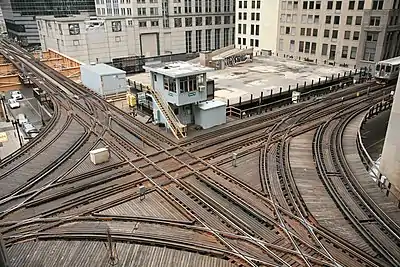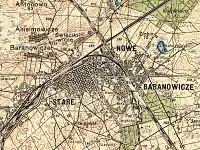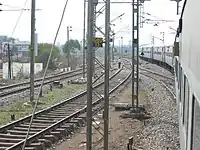
A junction, in the context of rail transport, is a place at which two or more rail routes converge or diverge. This implies a physical connection between the tracks of the two routes (assuming they are of the same gauge), provided by points (US: switches) and signalling.[1] Junctions are important for rail systems, their installation into a rail system can expand route capacity, and have a powerful impact upon on-time performance.
Overview

In a simple case where two routes with one or two tracks each meet at a junction, a fairly simple layout of tracks suffices to allow trains to transfer from one route to the other. More complicated junctions are needed to permit trains to travel in either direction after joining the new route, for example by providing a triangular track layout. In this latter case, the three points of the triangle may be given different names, for example using points of the compass as well as the name of the overall place.
Rail transport operations refer to stations that lie on or near a railway junction as a junction station. In the UK it is customary for the junction (and the related station) to be named after the next station on the branch, e.g. Yeovil Junction is on the mainline railway south of Yeovil, and the next destination on the branch is Yeovil Pen Mill. Frequently, trains are built up and taken apart (separated) at such stations so that the same train can be divided and proceed to multiple destinations. For goods trains (US: freight trains), marshalling yards (US: Classification yards) serve a similar purpose.
The world's first railway junction was Newton Junction (now Earlestown station) near Newton-le-Willows, England where, in 1831, two railways merged.
Measures to improve junction capacity
The capacity of the junctions limits the capacity of a railway network more than the capacity of individual railway lines. This applies more as the network density increases. Measures to improve junctions are often more useful than building new railway lines. The capacity of a railway junction can be increased with improved signaling measures, by building points suitable for higher speeds, or by turning level junctions into flying junctions, where tracks are grade-separated, and so one track passes over or under another.[2] With more complicated junctions such construction can rapidly become very expensive, especially if space is restricted by tunnels, bridges or inner-city tracks.
Avoiding the need for junctions
The installation of junctions into a rail system poses many challenges, including increased maintenance costs, and problems in on-time performance. Metro rail systems have a rail network design where the number of junctions is minimized. Passengers, and not trains, move from one train station to another.
Gallery
 Junction in track of Singapore LRT
Junction in track of Singapore LRT
 A junction in Baranowicze, Poland, 1934 (since 1939 in Belarus)
A junction in Baranowicze, Poland, 1934 (since 1939 in Belarus) A train passing through Katni Junction in Madhya Pradesh, India
A train passing through Katni Junction in Madhya Pradesh, India
See also
References
- ↑ Airey, John (2010). Railway Junction Diagrams (reprint ed.). BiblioBazaar. ISBN 9781145129566.
- ↑ Woodcock, Ian. "Of Skyrails and Skytrains - Elevated rail in the Australasian urban transport environment" (PDF). Australian Transport Research Forum. Retrieved 16 September 2018.
External links
 Media related to Rail junctions at Wikimedia Commons
Media related to Rail junctions at Wikimedia Commons